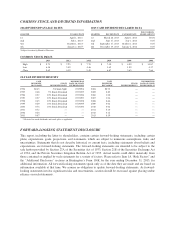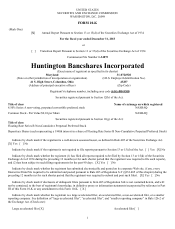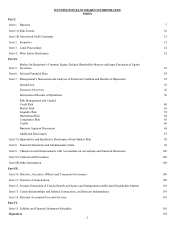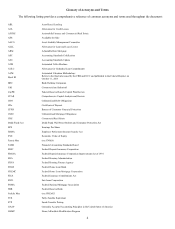Huntington National Bank 2013 Annual Report Download - page 16
Download and view the complete annual report
Please find page 16 of the 2013 Huntington National Bank annual report below. You can navigate through the pages in the report by either clicking on the pages listed below, or by using the keyword search tool below to find specific information within the annual report.10
We are a bank holding company and are qualified as a financial holding company with the Federal Reserve. We are subject to
examination and supervision by the Federal Reserve pursuant to the Bank Holding Company Act. We are required to file reports and
other information regarding our business operations and the business operations of our subsidiaries with the Federal Reserve.
The Federal Reserve maintains a bank holding company rating system that emphasizes risk management, introduces a framework
for analyzing and rating financial factors, and provides a framework for assessing and rating the potential impact of non-depository
entities of a holding company on its subsidiary depository institution(s). The ratings assigned to us, like those assigned to other
financial institutions, are confidential and may not be disclosed, except to the extent required by law.
The Federal Reserve utilizes an updated framework for the consolidated supervision of large financial institutions, including bank
holding companies with consolidated assets of $50 billion or more. The objectives of the framework are to enhance the resilience of a
firm, lower the probability of its failure, and reduce the impact on the financial system in the event of an institution’s failure. With
regard to resiliency, each firm is expected to ensure that the consolidated organization and its core business lines can survive under a
broad range of internal or external stresses. This requires financial resilience by maintaining sufficient capital and liquidity, and
operational resilience by maintaining effective corporate governance, risk management, and recovery planning. With respect to
lowering the probability of failure, each firm is expected to ensure the sustainability of its critical operations and banking offices under
a broad range of internal or external stresses. This requires, among other things, effective resolution planning that addresses the
complexity and the interconnectivity of the firm’s operations.
The Bank, which is chartered by the OCC, is a national bank and our only bank subsidiary. It is subject to examination and
supervision by the OCC and also by the CFPB, which was established by the Dodd-Frank Act in 2010. Our nonbank subsidiaries are
also subject to examination and supervision by the Federal Reserve or, in the case of nonbank subsidiaries of the Bank, by the OCC.
All subsidiaries are subject to examination and supervision by the CFPB to the extent they offer any consumer financial products or
services. Our subsidiaries are subject to examination by other federal and state agencies, including, in the case of certain securities
and investment management activities, regulation by the SEC and the Financial Industry Regulatory Authority.
The Bank is subject to affiliate transaction restrictions under federal law, which limit certain transactions generally involving the
transfer of funds by a bank or its subsidiaries to its parent corporation or any nonbank subsidiary of its parent corporation, whether in
the form of loans, extensions of credit, investments, or asset purchases, or otherwise undertaking certain obligations on behalf of such
affiliates. See also the Volcker Rule discussion below for additional affiliate transaction restrictions.
Legislative and regulatory reforms continue to have significant impacts throughout the financial services industry.
The Dodd-Frank Act, enacted in 2010, is complex and broad in scope and several of its provisions are still being implemented.
The Dodd-Frank Act established the CFPB, which has extensive regulatory and enforcement powers over consumer financial products
and services, and the Financial Stability Oversight Council, which has oversight authority for monitoring and regulating systemic risk.
In addition, the Dodd-Frank Act altered the authority and duties of the federal banking and securities regulatory agencies,
implemented certain corporate governance requirements for all public companies including financial institutions with regard to
executive compensation, proxy access by shareholders, and certain whistleblower provisions, and restricted certain proprietary trading
and hedge fund and private equity activities of banks and their affiliates. The Dodd-Frank Act also required the issuance of numerous
implementing regulations, many of which have not yet been issued. The regulations will continue to take effect over several more
years, continuing to make it difficult to anticipate the overall impact to us, our customers, or the financial industry in general.
In mid-January 2013, the CFPB issued eight final regulations governing mainly consumer mortgage lending. The first of these
rules was issued on January 10, 2013, and included the ability to repay and qualified mortgage rule. This rule imposes additional
requirements on lenders, including rules designed to require lenders to ensure borrowers’ ability to repay their mortgage and took
effect January 10, 2014. The same day, the CFPB also finalized a rule on escrow accounts for higher priced mortgage loans and a rule
expanding the scope of the high-cost mortgage provision in the Truth in Lending Act. On January 17, 2013, the CFPB issued its final
rules implementing provisions of the Dodd-Frank Act that relate to mortgage servicing, which took effect on January 10, 2014. On
January 18, 2013, the CFPB issued a final appraisal rule under the Equal Credit Opportunity Act and six agencies including the CFPB,
FRB, OCC, FDIC, NCUA, and FHFA issued an interagency rule on appraisals for higher-priced mortgage loans. On November 20,
2013, the CFPB issued its final rule on integrated mortgage disclosures under the Truth in Lending Act and the Real Estate Settlement
Procedures Act, for which compliance is required by August 1, 2015. We are evaluating these integrated mortgage disclosure rules to
determine their impact on the Bank and its affiliates.
During the 2013 first quarter, the CFPB provided guidance on fair lending practices to indirect automobile lenders with
recommendations to ensure compliance with fair lending laws.
























